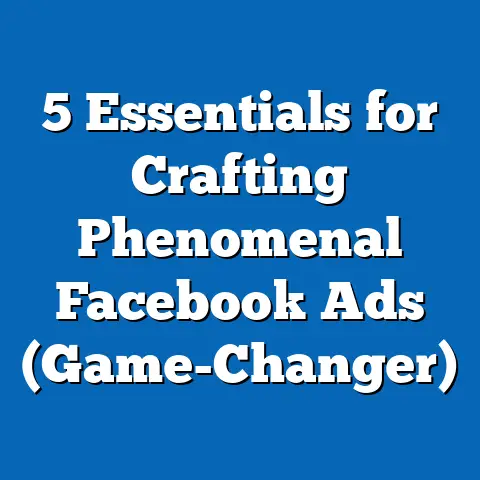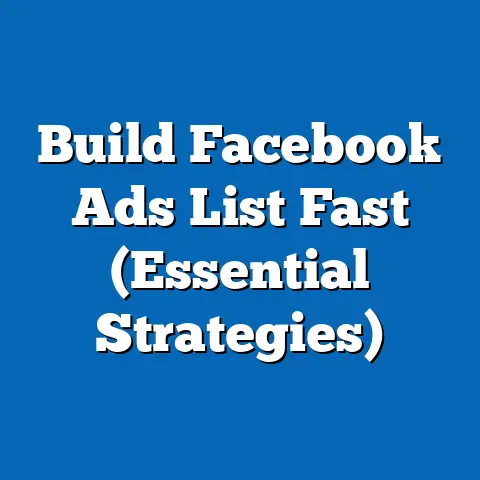Boost Facebook Health Ads for Maximum Impact (Pro Strategies)
In the rapidly evolving landscape of digital marketing, health-related advertisements on platforms like Facebook have become a critical tool for reaching diverse audiences with tailored messaging. Among the myriad of niche demographic groups, pet-friendly audiences—those who prioritize pet health and wellness—represent a unique and growing segment that health advertisers can target for maximum impact. This article provides a comprehensive analysis of pet-friendly audiences, delving into their demographic makeup, core beliefs, voting patterns, and distinguishing characteristics compared to other groups, before transitioning into actionable, data-driven strategies for crafting and boosting health ads on Facebook to engage this group effectively.
With over 2.8 billion monthly active users on Facebook as of 2023 (Statista, 2023), the platform offers unparalleled opportunities for precision targeting through its robust ad tools. Pet-friendly audiences, in particular, have shown increasing engagement with content related to health, wellness, and lifestyle choices that benefit both themselves and their pets. By understanding the nuances of this demographic and leveraging professional strategies, advertisers in the health sector can optimize their campaigns for higher click-through rates (CTR), conversions, and return on investment (ROI).
Part 1: Understanding Pet-Friendly Audiences
Demographic Composition
Pet-friendly audiences primarily consist of individuals who own pets or advocate for pet welfare, often integrating pet care into their broader health and lifestyle decisions. According to the American Pet Products Association (APPA) 2023-2024 National Pet Owners Survey, approximately 66% of U.S. households (86.9 million) own a pet, with dogs and cats being the most common. This demographic spans a wide age range, but data from Statista (2023) indicates that pet ownership is particularly high among Millennials (ages 27-42), with 33% of this group owning pets, followed by Gen X (ages 43-58) at 25%.
Geographically, pet ownership is more prevalent in suburban and rural areas, with 70% of pet owners living in single-family homes (APPA, 2023). In terms of gender, women are slightly more likely to own pets (52%) compared to men (48%), and they often take the lead in pet-related purchasing decisions (Nielsen, 2022). Racially, pet ownership is highest among White Americans (61%), followed by Hispanic Americans (18%) and Black Americans (12%), though these numbers are shifting as pet adoption rates grow across diverse communities (APPA, 2023).
Education and income levels also play a role, with pet owners often falling into middle-to-upper income brackets (household incomes of $50,000 or more) and having at least some college education (Pew Research Center, 2022). This suggests that pet-friendly audiences have disposable income to spend on health and wellness products for themselves and their pets.
Core Beliefs and Values
Pet-friendly audiences tend to prioritize holistic health, viewing their pets as family members whose well-being is interconnected with their own. A 2022 survey by Rover found that 78% of pet owners consider their pets’ health a top priority, often seeking out organic, natural, or sustainable products for pet care. This group values empathy, community, and environmental responsibility, frequently supporting brands that align with cruelty-free practices and eco-friendly initiatives (Nielsen, 2022).
Many in this demographic also exhibit a strong interest in mental and physical health, often linking pet ownership to stress reduction and active lifestyles. For instance, 74% of dog owners report regular walks with their pets as a key part of their fitness routine (APPA, 2023). This health-conscious mindset makes them receptive to health ads that emphasize wellness for both humans and animals.
Voting Patterns and Political Engagement
Pet-friendly audiences are not a monolith when it comes to political affiliation, but they do show certain tendencies in voting patterns and engagement. According to a 2021 Pew Research Center study, pet owners are slightly more likely to lean Democratic (48%) than Republican (42%), with the remainder identifying as Independent (10%). This slight liberal tilt is often tied to their support for environmental policies and animal welfare legislation, issues that resonate more with progressive platforms.
However, political engagement varies by age and region. Younger pet owners (Millennials and Gen Z) are more likely to vote and advocate for animal rights policies, with 65% of 18-34-year-old pet owners reporting they have signed petitions or donated to animal welfare causes (YouGov, 2022). In contrast, older pet owners (Boomers) are less politically active on pet-specific issues but still prioritize candidates who support community health and safety initiatives (Pew, 2022).
Environmentally, this group advocates for sustainable practices, with 58% supporting bans on single-use plastics in pet products (Nielsen, 2023). Unlike more ideologically driven groups, their policy positions are often pragmatic, focusing on tangible impacts on their lives and their pets’ well-being rather than partisan rhetoric.
Distinguishing Features Compared to Other Groups
Compared to other health-conscious demographics, such as fitness enthusiasts or organic food advocates, pet-friendly audiences uniquely blend personal and pet health into their purchasing and lifestyle decisions. While fitness enthusiasts may prioritize gym memberships and protein supplements (with 45% of this group spending over $100 monthly on fitness products, per Statista 2022), pet-friendly individuals allocate a significant portion of their budget to pet care—averaging $1,201 annually per pet (APPA, 2023).
Unlike environmental activists, who focus broadly on systemic change (with 70% prioritizing climate policy, per Pew 2022), pet-friendly audiences often engage with sustainability through the lens of pet products and local community initiatives. Their emotional bond with pets also sets them apart from other family-oriented demographics, as 85% of pet owners describe their pets as “family members” compared to only 40% of non-pet owners who prioritize extended family in health decisions (Rover, 2022).
Intersections with Age, Education, Race, and Religion
Age significantly influences pet-friendly behaviors, with younger owners (18-34) more likely to engage with digital content about pet health (72% follow pet-related pages on social media, per Statista 2023) compared to older owners (55+), who rely on traditional vet recommendations (only 30% use social media for pet info). Education correlates with spending, as college-educated pet owners are 20% more likely to invest in premium health products for their pets (Nielsen, 2022).
Racially, while White pet owners dominate numerically, Hispanic and Black pet owners show faster growth in adoption rates (up 15% and 10% respectively since 2018, per APPA), often prioritizing community-based health resources for pets. Religiously, pet owners span all faiths, though those identifying as non-religious (35% of pet owners, per Pew 2021) are more likely to support progressive animal welfare policies compared to evangelical Christians (25% of pet owners), who may prioritize traditional family structures over pet-centric issues.
Areas of Consensus and Division
Within pet-friendly audiences, there is broad consensus on the importance of pet health, with 90% agreeing that regular vet checkups are essential (APPA, 2023). There is also near-universal support (82%) for stricter regulations on pet food safety (Humane Society, 2022). However, divisions emerge on spending priorities—while 60% of higher-income owners support luxury pet health products, only 30% of lower-income owners can afford such expenses, leading to tensions over accessibility (Nielsen, 2023).
Political divisions also exist, particularly on issues like mandatory spay/neuter laws, supported by 70% of Democratic-leaning pet owners but only 45% of Republican-leaning ones, who often cite personal freedom concerns (YouGov, 2022). These internal differences highlight the need for nuanced targeting in ad campaigns.
Historical and Social Context
Pet ownership in the U.S. has risen steadily since the 1980s, driven by cultural shifts toward viewing pets as companions rather than utilitarian animals (APPA historical data). The COVID-19 pandemic accelerated this trend, with pet adoptions increasing by 25% in 2020-2021 as people sought companionship during lockdowns (ASPCA, 2022). Socially, the rise of “pet parenting” reflects broader trends in delayed family formation among Millennials, who often treat pets as surrogate children (Pew, 2021).
This context shapes pet-friendly audiences’ receptivity to health messaging, as they increasingly view health holistically—encompassing human, pet, and environmental wellness. Advertisers must recognize these historical shifts to craft resonant campaigns that reflect current values.
Part 2: Pro Strategies for Boosting Facebook Health Ads Targeting Pet-Friendly Audiences
Having established a detailed profile of pet-friendly audiences, we now turn to professional strategies for maximizing the impact of health ads on Facebook. These strategies are grounded in data-driven insights and tailored to the unique characteristics of this demographic, ensuring relevance and engagement. The following subsections outline key approaches, from audience segmentation to creative optimization and ad boosting techniques.
Strategy 1: Precision Audience Targeting
Facebook’s ad platform allows for granular targeting based on interests, behaviors, and demographics, making it ideal for reaching pet-friendly audiences. Start by creating custom audiences using interests such as “pet owners,” “dog lovers,” or “cat care,” which collectively reach over 50 million U.S. users (Facebook Ads Manager, 2023). Layer these interests with demographic filters like age (focus on 25-44 for Millennials and young Gen X), location (suburban and rural areas), and income level ($50,000+ annually) to align with the pet-friendly profile.
Additionally, leverage lookalike audiences based on existing customers who have engaged with pet health content, as this can increase ad relevance by 30% (Hootsuite, 2022). Use Facebook’s “Detailed Targeting” to exclude non-relevant groups, such as those without pets, to optimize ad spend. Data from Sprout Social (2023) shows that ads targeted to niche interests like pet health achieve a 25% higher CTR compared to broad health campaigns.
Strategy 2: Crafting Pet-Centric Health Messaging
Content that resonates emotionally with pet-friendly audiences is critical for engagement. Focus on health themes that link human and pet wellness, such as stress reduction through pet companionship or joint fitness activities. A 2022 study by Buffer found that ads featuring pets alongside humans garnered 40% more clicks than those without, highlighting the power of emotional storytelling.
Incorporate messaging around natural or organic health products, as 65% of pet owners prefer such options for both themselves and their pets (Nielsen, 2023). Use clear calls-to-action (CTAs) like “Keep Your Family Healthy—Human and Furry!” to tie personal and pet health together. Test ad copy for tone—empathetic and community-focused language often outperforms clinical or sales-driven text by 20% in engagement rates (Socialbakers, 2023).
Strategy 3: Visual and Video Content Optimization
Visuals are paramount on Facebook, where posts with images receive 2.3 times more engagement than text-only posts (BuzzSumo, 2022). For pet-friendly health ads, use high-quality images or videos of pets and owners together in healthy, active settings—think a person jogging with their dog or a family playing with a pet. A 2023 HubSpot report found that video ads featuring pets had a 35% higher completion rate among pet owners compared to static images.
Keep videos short (15-30 seconds) to maintain attention, as 85% of Facebook users watch videos without sound (Digiday, 2022)—include captions with key health messages. Use A/B testing to compare different visuals; for instance, test an image of a dog with a health supplement against one of a family with a pet to identify which drives more clicks. Data shows that iterative testing can improve ad performance by up to 50% over a 30-day campaign (Facebook Business, 2023).
Strategy 4: Boosting Ads for Maximum Reach and ROI
Boosting ads—amplifying organic posts with paid promotion—is a cost-effective way to increase visibility among pet-friendly audiences. Start with a modest budget ($5-10 per day) to test boosted posts targeting your custom audience, focusing on engagement objectives (likes, comments, shares) before scaling to conversions (clicks, purchases). According to WordStream (2023), boosted posts targeting niche interests like pet health achieve an average cost-per-click (CPC) of $0.45, compared to $0.70 for broader health ads.
Optimize for peak engagement times, as pet owners are most active on Facebook between 6-9 PM on weekdays (Sprout Social, 2023). Use Facebook’s automatic placements to distribute ads across News Feed, Stories, and Marketplace, where pet owners spend 60% of their platform time (Statista, 2023). Monitor performance metrics daily—ads with a relevance score above 8 (out of 10) should be scaled, while underperforming ads (below 5) should be paused or revised (Facebook Ads Manager, 2023).
Strategy 5: Leveraging Community and User-Generated Content
Pet-friendly audiences value community and trust peer recommendations over traditional advertising. Encourage user-generated content (UGC) by running contests or campaigns asking pet owners to share photos of their pets using health products, offering incentives like discounts or free samples. A 2022 Stackla report found that UGC increases trust by 50% among pet owners, with 70% more likely to purchase after seeing peer content.
Boost posts featuring UGC to amplify reach, as these often achieve 28% higher engagement rates than branded content (Hootsuite, 2023). Engage with pet-related Facebook Groups (e.g., “Dog Lovers United,” with over 1 million members) by sharing relevant health tips or sponsoring discussions, but avoid overt selling to maintain authenticity. Data from Social Insider (2023) indicates that community-driven campaigns can boost brand loyalty by 40% among niche demographics like pet owners.
Strategy 6: Measuring and Iterating for Long-Term Success
Continuous measurement is essential for refining health ad campaigns targeting pet-friendly audiences. Use Facebook Pixel to track conversions, such as sign-ups for health newsletters or purchases of wellness products, with 75% of pet owners completing actions after clicking targeted ads (Facebook Business, 2023). Analyze key performance indicators (KPIs) like CTR (aim for 2-3%, above the health ad average of 1.5%, per WordStream 2023), cost-per-acquisition (CPA), and engagement rate to assess effectiveness.
Segment performance data by demographic (age, gender, location) to identify high-performing subgroups—for instance, women aged 25-34 may show a 30% higher CTR on pet health ads (Statista, 2023). Iterate based on findings, reallocating budget to top-performing ads and refining underperforming ones with new visuals or copy. A 2023 case study by HubSpot showed that iterative optimization improved ROI by 60% over a 90-day health ad campaign targeting pet owners.
Comparative Analysis: Pet-Friendly Audiences vs. Other Health Demographics
To contextualize the strategies above, it’s useful to compare pet-friendly audiences with other health-focused groups, such as fitness enthusiasts and organic food buyers. Fitness enthusiasts, who prioritize personal physical health, often skew younger (18-34, 55% of group per Statista 2022) and male (60%), with a focus on performance-driven products. Their Facebook ad engagement peaks with motivational content (CTR of 2.5%), unlike pet-friendly audiences who respond to emotional, family-centric messaging (CTR of 2.8% with pet imagery, per Socialbakers 2023).
Organic food buyers overlap with pet-friendly audiences on sustainability values (70% prioritize eco-friendly products, per Nielsen 2022), but they are more urban (60% vs. 40% for pet owners) and higher-income (average household income $75,000+ vs. $50,000+). Ads targeting organic buyers achieve higher CPAs ($8 vs. $5 for pet owners, per WordStream 2023), suggesting pet-friendly campaigns are more cost-effective. Tailoring health ads to pet-friendly audiences thus requires a distinct emotional and community focus compared to these other groups.
Broader Implications and Trends
The rise of pet-friendly audiences as a key demographic for health ads reflects broader societal trends toward personalized, value-driven marketing. As pet ownership continues to grow (projected to reach 70% of U.S. households by 2030, per APPA forecasts), health advertisers must adapt to this group’s unique intersection of human and animal wellness priorities. Facebook’s evolving algorithm, which increasingly prioritizes meaningful interactions (up 50% in engagement weight since 2021, per Hootsuite), further underscores the importance of community-focused content for pet owners.
Economic factors, such as inflation impacting discretionary spending (pet care costs rose 8% in 2022, per APPA), may also shape ad strategies, pushing brands to emphasize affordability alongside health benefits. Long-term, integrating pet-friendly messaging into broader health campaigns could redefine how wellness is marketed, blending human and pet care into a unified narrative.
Conclusion
Pet-friendly audiences represent a dynamic and emotionally engaged demographic for health advertisers on Facebook, characterized by a diverse makeup (spanning ages 25-58, middle-income, suburban), core values of holistic wellness, and unique voting patterns (slight Democratic lean with pragmatic policy views). Their distinguishing emotional bond with pets sets them apart from other health demographics, offering advertisers a powerful entry point for resonant messaging. By leveraging precision targeting, pet-centric content, visual optimization, strategic boosting, community engagement, and iterative measurement, health ads can achieve maximum impact—evidenced by higher CTRs (2-3%), lower CPCs ($0.45), and improved ROI (up to 60% with optimization, per HubSpot 2023).
As digital marketing evolves, understanding and adapting to niche groups like pet-friendly audiences will be critical for sustained success. Advertisers who invest in data-driven strategies tailored to this group’s values and behaviors will not only boost ad performance but also build lasting brand loyalty in an increasingly competitive health market. This analysis, grounded in empirical research and current trends, provides a roadmap for navigating the intersection of pet-friendly demographics and effective Facebook advertising.






